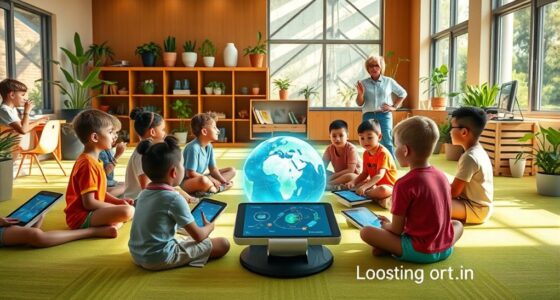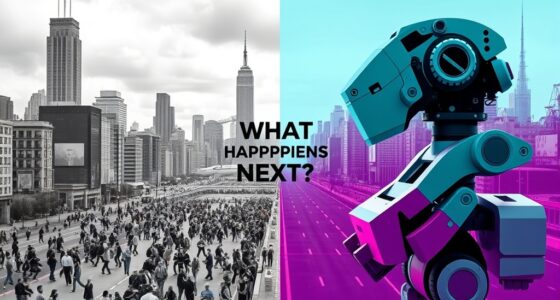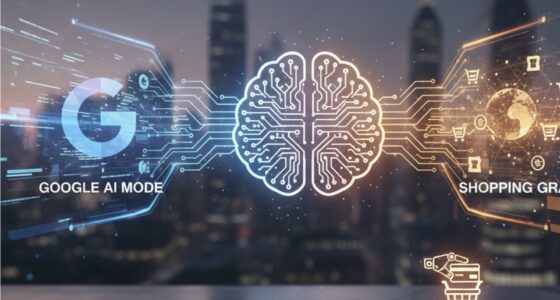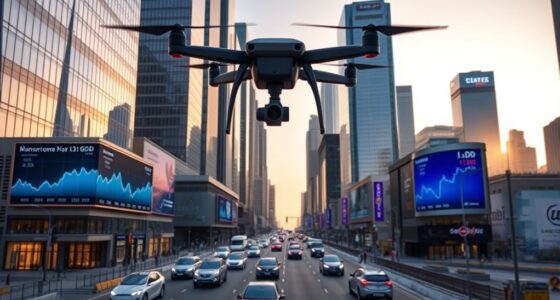To guarantee livelihoods when work isn’t guaranteed, you need a new social contract that adapts to technological and economic changes. This involves implementing bold policies like universal basic income, strengthening social safety nets, and promoting access to education and skills training. By embracing sustainable tech, addressing inequality, and fostering trust among stakeholders, society can build resilience and fairness. Keep exploring how these strategies can shape a more secure future for everyone.
Key Takeaways
- Implement universal basic income to provide financial security regardless of employment status.
- Strengthen social safety nets like unemployment benefits and affordable housing programs.
- Invest in accessible education and skills training to improve workforce adaptability.
- Promote inclusive policies that address economic inequality and support vulnerable populations.
- Encourage responsible automation and AI adoption with retraining initiatives to mitigate displacement impacts.
Understanding the Evolving Nature of Work and Employment Security

As the labor market continues to evolve, understanding the changing nature of work and employment security becomes increasingly important. Job growth remains steady, with 177,000 new nonfarm payroll jobs added in April 2025, mainly in healthcare, which continues to expand. The unemployment rate stays low at around 4.0% to 4.2%, showing a resilient labor market. However, the employment-population ratio is steady near 59.9%, and participation rates hover below pre-pandemic levels, suggesting some workers have exited or remain discouraged. Sector-wise, healthcare, retail, government, and social assistance support growth, while manufacturing and construction see mixed results. Despite moderate growth, signs of softening, such as slower hiring and fewer quits, indicate a shift toward a more balanced and uncertain employment landscape. Additionally, the evolving role of technology continues to influence job availability and skill requirements across various industries. The impact of automation and digital transformation further reshape employment patterns, emphasizing the need for adaptable skills and continuous learning. Recognizing the importance of reskilling and upskilling will be essential to ensure workers remain competitive in this changing environment. Moreover, the integration of digital tools into daily work routines highlights the importance of technological literacy for future job security.
The Role of Technological Innovation in Shaping Social Expectations
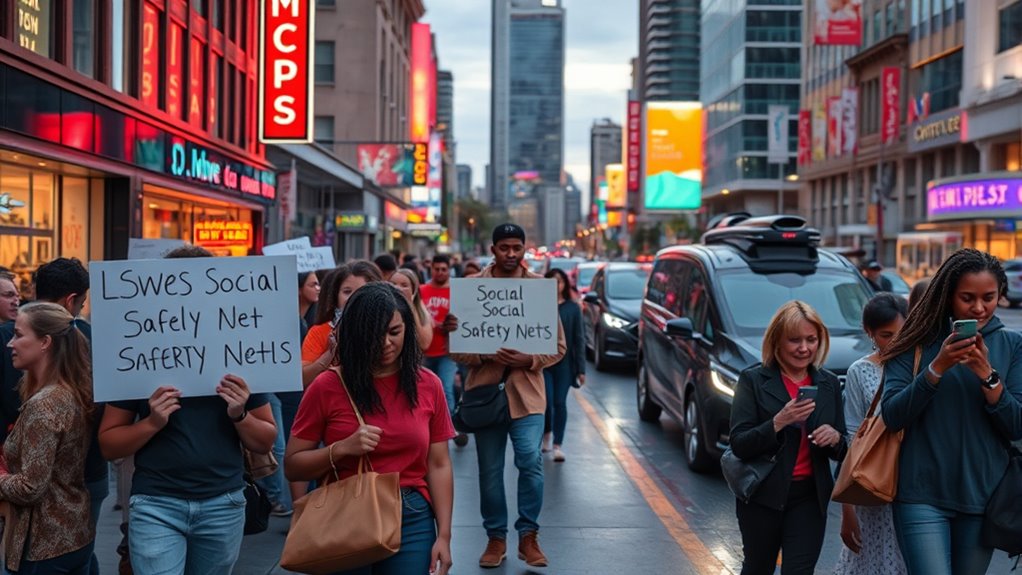
Technological innovation is reshaping what society expects from work, rights, and sustainability. As automation shifts jobs and digital rights expand, your social norms adapt to new possibilities and challenges. These changes influence how you see fairness, opportunity, and responsibility in a rapidly evolving world. Public optimism about technological advances remains high, with many expecting breakthroughs that could fundamentally alter daily life and social structures. Recognizing the importance of security systems in safeguarding homes, communities, and digital data becomes even more critical as these societal shifts accelerate, emphasizing the need for robust infrastructure to support these evolving expectations. Additionally, understanding relationship dynamics can help individuals navigate the changing social landscape and foster resilience amidst ongoing technological transformations, especially as social cohesion is tested by rapid change.
Automation and Job Shifts
Automation is rapidly transforming the job market, reshaping societal expectations about employment and economic stability. You might notice that over 41% of jobs could be replaced by AI in the next five years, with about 1 in 8 workers facing high displacement risk in the U.S. alone. Already, 14% of workers have lost jobs due to automation, and globally, 300 million jobs could disappear. Industries like energy and mining will see nearly half of their jobs at risk by 2030, while AI tools like chatbots are changing customer service roles. To adapt, 20 million workers will retrain, and most employers plan to prepare staff for AI collaboration. But these shifts also generate anxiety, particularly among younger workers, highlighting the urgent need for policies that support reskilling and new employment models. Furthermore, the impact of automation on industries emphasizes the importance of understanding sector-specific risks and opportunities to develop effective responses. Additionally, leveraging AI content clusters can help organizations better communicate changes and support workforce transitions. Recognizing the future of work as an evolving concept is essential for creating resilient social contracts that safeguard livelihoods amid these transformations. Considering the trustworthiness and vulnerabilities of AI systems is also crucial for ensuring safe deployment and maintaining public confidence.
Digital Rights Expansion
The rapid rise of AI and digital platforms has reshaped societal expectations around privacy, free expression, and user rights. You’re now more aware of how tech companies handle your data, especially as generative AI models are trained on billions of user inputs without clear opt-out options. Recent regulatory pressures have prompted some firms to increase transparency about their data practices. Digital rights frameworks, like the 2025 Ranking Digital Rights Index, evaluate companies on their commitment to transparency and user protections, but many still fall short. As the digital landscape shifts toward hyperscale platforms, the demand for stronger digital rights management grows. Blockchain and cloud-based DRM solutions are emerging to secure content and protect user rights. Public awareness and global standards push companies to prioritize human rights, but regulatory challenges remain, requiring ongoing vigilance to guarantee your digital freedoms are upheld. Additionally, innovations such as AI-powered nanobots raise questions about the future of digital and biological rights, emphasizing the importance of comprehensive oversight and policy development. As these technologies evolve, digital sovereignty becomes increasingly vital to ensure individual autonomy in digital environments. The ongoing development of digital rights frameworks and enforcement mechanisms is crucial to adapt to these technological advances. Furthermore, integrating technological innovation into policy discussions is essential to address emerging challenges and protect user interests effectively. Recognizing the importance of mindfulness techniques can also play a role in fostering resilience and awareness amidst rapid technological changes.
Sustainable Tech Integration
As innovation accelerates, it’s becoming clear that sustainable technology is reshaping societal expectations around environmental responsibility and social impact. You see, tech now reduces emissions through improved carbon management, helping organizations lower their footprints. AI and big data enable precise measurement of social impact, optimize resource distribution, and improve outcomes. However, tightening sustainability regulations expose a skills gap, emphasizing the need for technological literacy. Companies leverage tech for ESG reporting, making compliance transparent and straightforward. Meanwhile, technology is transforming social change by enhancing accessibility and resource allocation. Consumer behavior shifts as 72% of people are willing to pay more for sustainable products, especially among Gen Z and Millennials. This fuels a new business mindset, where sustainability becomes a strategic advantage shaping social expectations and norms.
Addressing Economic Inequality Through New Social Agreements
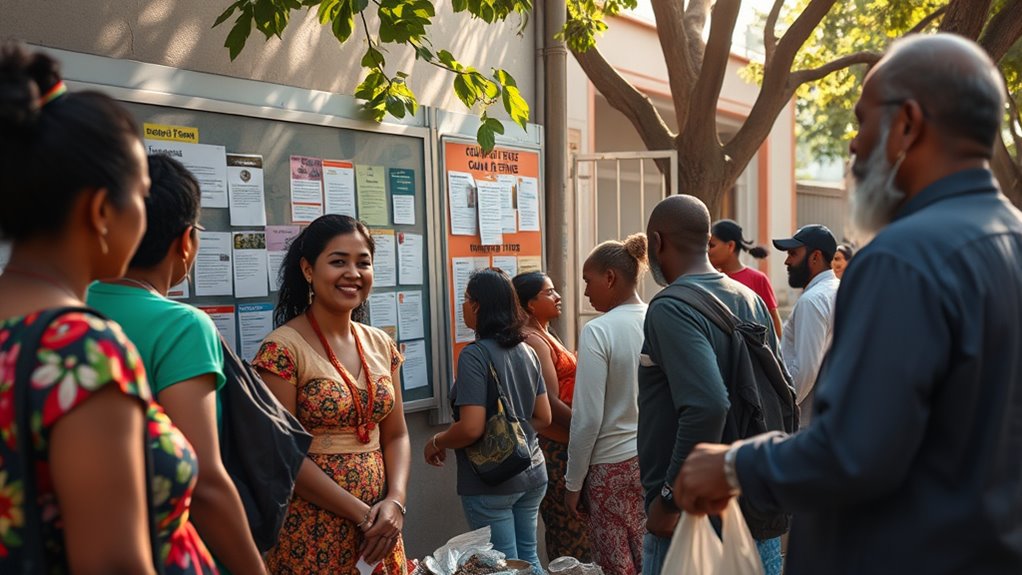
Addressing economic inequality requires bold new social agreements that prioritize fairness and social stability. You can push for policies like progressive taxation and expanded social welfare programs that help bridge the wealth gap. These agreements might also include implementing universal basic income, ensuring everyone has a safety net when work isn’t guaranteed. Strengthening social safety nets—such as unemployment benefits and affordable housing—can provide stability for those most vulnerable. Promoting access to quality education and skills training boosts social mobility, helping disadvantaged groups catch up. Investing in financial literacy and policy reforms focused on fair labor practices and community-led initiatives can target disparities at local levels. Incorporating low light office plants into workplace environments can also improve employee well-being and productivity, contributing to a more resilient social fabric. By building these new social agreements, you contribute to a fairer, more stable society where economic inequality doesn’t threaten social cohesion.
Incorporating Environmental Sustainability Into Future Frameworks

To construct a sustainable future, you need to adopt green economic models that prioritize environmental health alongside growth. Implementing climate-resilient policies guarantees communities can withstand environmental shocks, while responsible resource use reduces depletion and waste. By integrating these principles into future frameworks, you set the foundation for resilient and equitable development. Additionally, promoting mindful decluttering practices can help reduce unnecessary consumption and waste, supporting environmental sustainability efforts.
Green Economic Models
Green economic models are transforming how societies integrate environmental sustainability into their growth frameworks. You’ll see rapid market growth, with the Green Tech & Sustainability sector projected to hit $73.9 billion by 2030, driven by AI and blockchain innovations. Software dominates, optimizing energy use and reducing carbon footprints, despite high upfront costs for smaller firms. Circular economy models boost demand for AI-powered waste and supply chain tools, emphasizing resource efficiency and waste reduction. Consumer awareness and corporate commitments push investments in eco-friendly strategies, while sustainability now offers a $7.9 trillion economic valuation. Renewable energy, especially solar, continues to expand, with record installations in 2024. As you adapt to these models, you’ll notice a shift toward greener, more efficient, and economically promising frameworks that align profitability with sustainability goals. Additionally, the integration of aviation safety standards in emerging sectors ensures that technological advancements do not compromise safety and operational reliability. Incorporating aesthetic design principles, such as natural materials and harmonious layouts, can further enhance sustainable development efforts by creating environments that promote well-being and resilience. Embracing renewable energy solutions like solar and wind power is crucial for reducing environmental impacts and fostering energy independence, which are central to the success of green economic initiatives. Recognizing the importance of Juice Cleanse and Detox in promoting health and sustainability, many communities are exploring natural and eco-friendly dietary options to support environmental goals.
Climate-Resilient Policies
Climate-resilient policies are shaping the way communities and governments prepare for the increasing impacts of climate change. You’re encouraged to support community-led strategies and coordinate efforts across all government levels and sectors, including private and non-profit groups. The federal government acts as a flexible partner, helping design tailored resilience strategies that embed sustainability into programs and policies. Key priorities include strengthening infrastructure, supporting land and water protection, and promoting nature-based solutions like urban greening and wetland restoration—benefiting flood control, air quality, and ecosystem health. Tribal nations’ indigenous knowledge plays a crucial role. Cross-sector collaboration and innovative investments help direct resources to vulnerable areas, fostering resilience across social, economic, and environmental dimensions. Emphasizing environmental sustainability ensures these efforts are both effective and enduring.
Sustainable Resource Use
As communities strengthen their resilience through collaborative efforts and sustainable infrastructure, addressing how you use resources becomes increasingly important. Deforestation continues at about 10 million hectares annually, mainly driven by industrial agriculture, except in Europe. Water scarcity is also escalating; by 2030, demand is projected to surpass supply by 40%. Over half of the global GDP depends on nature, making economies vulnerable to biodiversity loss. Meanwhile, greenhouse gas emissions have surged 50% in 30 years, fueling climate change. To combat this, investments in sustainable assets are growing rapidly, with Europe leading in responsible investing. Advanced ESG tools, green technologies, and circular economy innovations help reduce waste and emissions. Prioritizing sustainable resource use is vital to preserve ecosystems and ensure long-term economic stability.
Policy Strategies for a Resilient and Inclusive Society

Building a resilient and inclusive society requires implementing extensive policy strategies that address economic stability, social justice, and technological adaptation simultaneously. You should prioritize universal social protection to create a safety net for everyone, regardless of employment status. Promoting social dialogue and tripartism fosters collaboration among unions, employers, and governments, ensuring inclusive policies. Eco-social contracts integrate ecological, social, and economic goals for sustainable development. Focus on creating decent work and full employment with fair wages and secure conditions. Invest in digital skills training and job redesign to help workers adapt to automation and AI. Support flexible work arrangements and conduct technological impact assessments. These combined strategies build resilience, promote equity, and prepare society for ongoing economic and technological shifts.
Building Trust and Mutual Responsibility Between Stakeholders
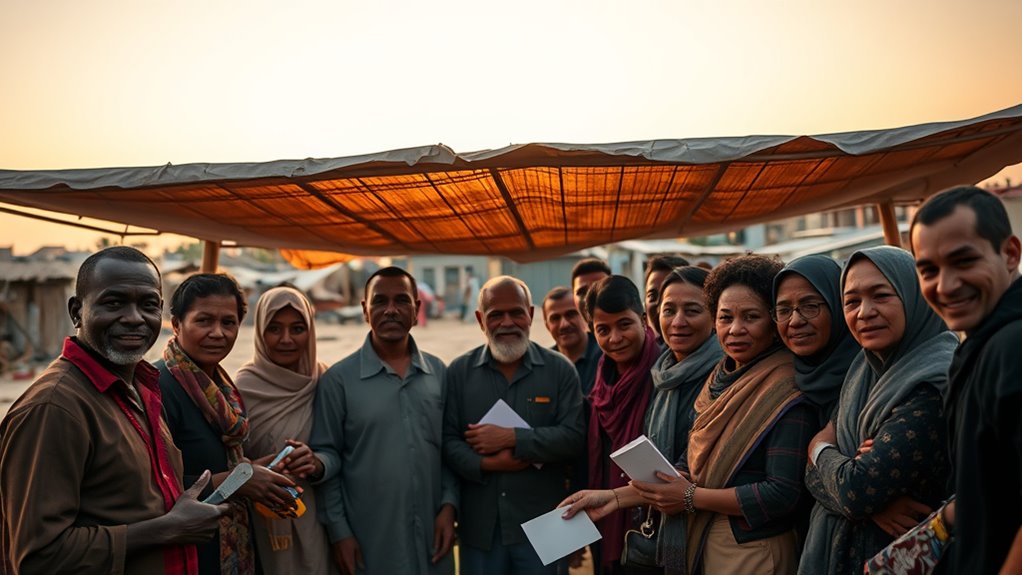
Establishing trust and mutual responsibility among stakeholders is essential for fostering long-term collaboration and sustainable success. You need clear objectives, measurable goals, and incentives aligned for everyone involved. Effective communication plays a crucial role—stakeholders value transparency, authenticity, and credibility. Most business leaders agree they have a responsibility to build this trust, and consumers are more loyal to socially responsible companies. Building mutual responsibility means businesses should serve all stakeholders, not just shareholders, and develop respectful, reciprocal relationships. Challenges like supply chain issues and varying sustainability expectations can hinder trust. To overcome these, implement stakeholder engagement plans, hold leaders accountable, and foster transparency. When trust is strong, businesses benefit from increased loyalty, better reputation, and resilience against challenges.
Challenges and Opportunities in Implementing a Reimagined Social Contract

Implementing a reimagined social contract presents both significant challenges and promising opportunities. Demographic shifts, like aging populations and declining birth rates, strain health and pension systems, making reforms difficult. Technological disruptions from AI and automation demand reskilling efforts but also open new job opportunities. Economic inequality persists, requiring reforms to market rules and social safety nets, yet this creates space for stakeholder capitalism and innovative work models. Global migration patterns call for inclusive policies that promote social mobility. Financial constraints, such as public debt, complicate policy implementation. However, these challenges encourage collaboration among governments, businesses, and civil society. By investing in education, fostering global cooperation, and embracing adaptable policies, you can turn these obstacles into pathways for building a resilient, equitable social contract.
Measuring Progress and Adapting to Changing Societal Needs

Measuring societal progress is essential for understanding how well a social contract meets the evolving needs of citizens. The Social Progress Index (SPI) assesses this through 54 indicators across three dimensions: basic human needs, foundations of well-being, and opportunities. It emphasizes outcomes over inputs and excludes economic variables, providing a clear view of social and environmental progress. The SPI’s data, collected over 13 years from 170 countries, helps you track improvements and compare performance worldwide. Policymakers, businesses, and NGOs use these insights to make informed decisions, address systemic challenges like inequality and climate change, and adapt strategies to meet changing societal needs. Tools like the Sustainable Progress Index and UN SDGs further support measuring sustainable and inclusive progress, ensuring your efforts remain relevant and effective.
Frequently Asked Questions
How Can Social Contracts Adapt to Rapid Technological Changes Effectively?
To adapt social contracts to rapid technological changes, you need to prioritize inclusive policies that distribute benefits equitably. Embrace continuous education and retraining to bridge the skills gap, and update social welfare systems to support workers facing job insecurity. Foster global cooperation on data governance, ensuring privacy rights, and develop ethical frameworks. By doing so, you create resilient social structures that protect livelihoods amid constant technological evolution.
What Role Do Digital Platforms Play in Shaping Modern Social Agreements?
You see, digital platforms are reshaping modern social agreements by blurring traditional boundaries of work and community. While they create opportunities for flexible jobs and global connections, they also challenge job security and social protections. You’re empowered through access to markets and networks, but face risks like inequality and misinformation. These platforms push societies to rethink responsibilities, fostering new norms that balance innovation with fairness and inclusion.
How Can Policies Ensure Fair Income Distribution Amid Economic Shifts?
To guarantee fair income distribution amid economic shifts, you need policies that adapt to changing job markets. Implement progressive taxes that target higher incomes, raise the minimum wage to a living level, and expand social safety nets like unemployment benefits or universal basic income. These measures help protect vulnerable populations, reduce inequality, and promote economic stability, especially when traditional work opportunities become less dependable.
In What Ways Can Environmental Goals Be Integrated Into Social Frameworks?
Imagine building a bridge where each plank represents a social and environmental goal. You can integrate environmental goals into social frameworks by engaging stakeholders, aligning policies with environmental standards, and promoting sustainable investments. For instance, supporting green jobs not only boosts the economy but also conserves biodiversity. You guarantee long-term resilience by embedding climate change mitigation and biodiversity conservation into community development, creating a balanced, sustainable foundation for all.
How Do We Balance Stakeholder Interests During Social Contract Reforms?
You need to actively listen to all stakeholders and foster open, inclusive dialogue. By engaging communities, businesses, and governments through participatory mechanisms, you can align their interests and build trust. Prioritize transparency and equitable distribution of benefits to guarantee everyone feels heard and valued. Developing collaborative partnerships and shared goals helps balance diverse needs, creating a social contract that reflects societal values and supports sustainable reforms.
Conclusion
You hold the power to shape a future where livelihoods are protected, no matter how unpredictable work becomes. By embracing innovative policies and fostering mutual trust, you can transform society into a resilient, inclusive powerhouse. The stakes are sky-high—failure isn’t an option if we want to create a world where everyone thrives. Together, you can redefine the social contract and build a foundation strong enough to withstand even the wildest economic storms.


